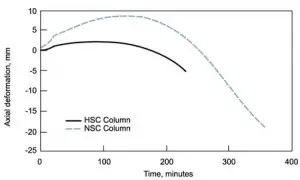With the passage of time, technology is getting more advanced and there has been a rapid growth in the concrete properties. Concrete is improving day by day. There is not yet been an exact definition of a word high strength concrete. But, generally it refers to that concrete having compressive strength in the range of 7000 Psi to 15000 Psi or higher than that.
In today’s world, there are large number of admixtures are available in the market that reduce the required amount of water. For example water reducing admixtures also named as super plasticizers. Some other plasticizers are set accelerator, set retarders, frost and sulfate resistance admixtures.
Manufacturing of high strength concrete is to be done with great care especially, during the selection of materials. Because, of widely available qualities of cement, sand, stone and admixtures. There are a large number of cement replacing agents are also available. For example fly ash, silica fume and slag.
High strength concrete helps to improve many other properties of concrete too. Due to which it can also be known as high performance concrete.
Requirements of high strength concrete
For high strength concrete an essential requirement is a low water to cement ratio i.e. 0.25 by weight of concrete or even lower than that. For normal concrete water to cement ratio lies within the range of 0.40 – 0.60 by weight.
This can be achieved by using high range water reducing admixtures and higher amount of cement. Super plasticizers increase the slum value almost 6 to 8 inches. In return, workability of concrete gets better and that assures proper placement of concrete.
Applications
There are many applications of high strength concrete, but some most common applications of high performance concrete are in columns of tall buildings. Where, if normal concrete is used then it would result in unacceptably large cross sections and it took valuable floor space too. Therefore, by using high strength concrete which in usually more expensive than normal concrete results in not only saving floor area but, also saves the extra steel reinforcement for an extra strength. If amount of steel reinforcement is increased instead of increasing concrete strength then the structure will not remain any more economical.
Examples of high strength concrete tall buildings are South Wacker (Chicago) and Central plaza (Hong Kong). South Wacker has a total height of 946ft and was lasting as a world record until completion of the central plaza formerly, holding the height record with a total height of 1230ft.
For lower story columns strength of concrete was specified up to 12000 Psi. In case of bridges, high strength concrete results in smaller cross sections. And it brings significant advantages by reducing the dead load of bridge span which permits the use of longer span. High strength concrete has a higher modulus of elasticity and lower creep coefficient that result in small deflection value.
There are many other applications of high strength concrete. Some most recent includes parking garages, brick deck overlays, warehouses, heavy industrial slabs and offshore oil structures.



A great clear cut answer and an excellent concept. But how do I post any work on this web site is an additional question. The Foureyed Poet. 118917